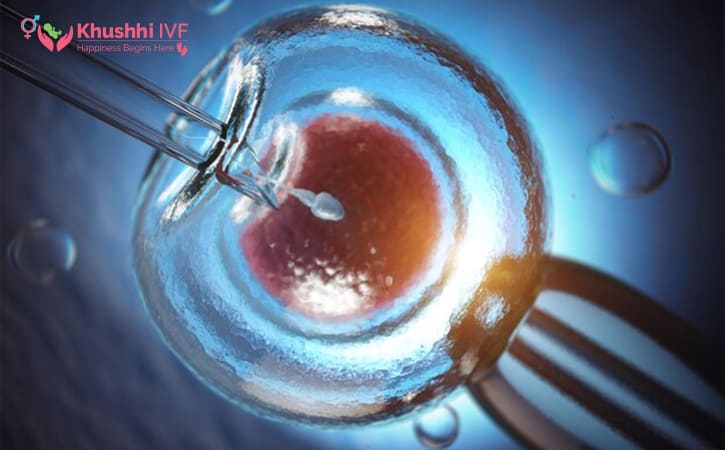Globally, approximately 1 in 6 individuals experience infertility, rendering them unable to conceive naturally. ART methods offer hope to these individuals by facilitating conception.
Intracytoplasmic Sperm Injection (ICSI), specifically, is a specialized technique that involves the direct injection of sperm into an egg to aid fertilization.
This guide aims to provide an overview of the ICSI procedure, its utilization, and the benefits it offers in the context of assisted reproductive technology.
What is Intracytoplasmic Sperm Injection (ICSI)?
Intracytoplasmic Sperm Injection (ICSI) is a procedure performed during the fertilization stage of the IVF process.
In IVF, there are two options for fertilization: conventional fertilization and ICSI.
In the conventional method, a large number of sperm are placed together with the egg in a petri dish, allowing the sperm to naturally fertilize the egg.
However, in the case of ICSI, a single sperm is directly injected into the cytoplasm of a mature oocyte (egg).
Once fertilized, the egg develops into an embryo. The embryo is then cultured in a laboratory for a period of 3 to 5 days before being transferred into the uterus.
Protocol of ICSI
The ICSI (Intracytoplasmic Sperm Injection) protocol involves several essential steps.
Stimulation of Ovaries – Firstly, the female’s ovaries are stimulated to produce multiple mature eggs through the administration of fertility drugs.
Retrieval of sperm and egg – Secondly, the egg retrieval process takes place, with the use of a needle guided by an ultrasound probe. The eggs are collected, while the sperm can be obtained through ejaculation or surgical extraction.
Injection of sperm into the egg – The selected sperm, determined by an embryologist, is then retrieved from its suspension using a bevelled and sharpened injection pipette, which grasps the sperm by its tail.
Simultaneously, the egg is held in place by a standard holding pipette.
The injection pipette subsequently releases the sperm into the egg, facilitating the process of fertilization.
Monitoring of embryo – After injection, the fertilized egg, now referred to as an embryo, is cultured for a period of 16-20 hours, during which time its development is closely monitored.
Transfer of Embryo – Finally, the resulting embryo is transferred into the uterus using an ultrasound-guided catheter, allowing for its implantation and further development.
Uses of ICSI
The use of Intracytoplasmic Sperm Injection (ICSI) has revolutionized the field of assisted reproductive technology, offering new possibilities for couples facing infertility challenges.
By directly injecting a single sperm into the cytoplasm of an egg, ICSI bypasses potential barriers to fertilization and enhances the chances of successful embryo development.
This groundbreaking procedure has significantly improved pregnancy rates for couples struggling with male factor infertility, providing them with a hopeful path towards parenthood.
Male Infertility
ICSI (Intracytoplasmic Sperm Injection) is a technique used in the treatment of male infertility.
Male infertility refers to the inability to conceive after 12 months of regular unprotected sex, often due to issues within the male reproductive system.
Poor sperm quality, including conditions such as low sperm count (oligospermia), abnormal sperm shape (teratozoospermia), or reduced sperm movement (asthenozoospermia), can contribute to male infertility.
Additionally, ejaculation problems like anejaculation (inability to ejaculate) or retrograde ejaculation (where semen enters the bladder instead of the urethra) can also lead to fertility issues.
Anatomical abnormalities, such as blockages in the male reproductive tract, can further contribute to male infertility.
ICSI-IVF can be used to conceive in all these conditions.
Furthermore, men who have undergone vasectomy may require ICSI as a potential solution.
Previous IVF Failure
In cases of previous IVF failure where few or no fertilized eggs were obtained, the use of ICSI (Intracytoplasmic Sperm Injection) can be considered.
If traditional IVF methods were previously utilized but failed to achieve embryo creation, and assessments of both sperm and eggs yielded normal and healthy outcomes with good sperm quality, there is a possibility that the problem lies in the fertilization process.
In such situations, the next cycle can be attempted using the ICSI method, where a single sperm is directly injected into each mature egg to facilitate fertilization and increase the chances of successful embryo development.
Use of Frozen Egg or Sperm
ICSI (Intracytoplasmic Sperm Injection) is recommended in cases where frozen sperm or eggs are used for conceiving through IVF.
Cryopreservation of sperm can sometimes render it inactive after the thawing process, which may affect its ability to fertilize an egg naturally.
Similarly, when the vitrification process (a fast-freezing technique) is used to freeze oocytes (eggs), it can lead to the hardening of the eggshell.
This hardening can make it challenging for sperm to penetrate and fertilize the egg effectively.
Consequently, the use of ICSI is preferred in such cases, as it involves directly injecting a single sperm into each mature egg, thereby bypassing any potential barriers to fertilization and increasing the chances of successful conception.
Patients using PGD
The use of ICSI (Intracytoplasmic Sperm Injection) is essential in cases where patients undergo PGD (Preimplantation Genetic Diagnosis) during IVF treatment.
PGD is a procedure conducted before embryo implantation to detect specific genetic disorders, aiming to select the best embryos with the highest likelihood of successful IVF outcomes.
In PGD, a biopsy of embryo cells is taken to test for specific genetic diseases.
ICSI is necessary in this context to increase the accuracy of the PGD test.
During conventional fertilization, there is a chance of sperm that attempted to penetrate the egg remaining adhered to its surface.
During the biopsy process, there is a possibility that the genetic material from these adhered sperm may be incorporated into the sample, potentially altering the outcome of the genetic test.
By using ICSI, where a single sperm is directly injected into each mature egg, the risk of contamination by adhered sperm is minimized, ensuring the accuracy of the PGD test and the selection of genetically healthy embryos for implantation.
IVM (in vitro maturation)
In cases where patients undergo IVM (in vitro maturation), the use of ICSI (Intracytoplasmic Sperm Injection) can be considered as an option for fertilization.
IVM involves the retrieval of immature eggs from the ovaries, followed by their maturation in a laboratory setting. This method is often chosen in cases of female infertility problems.
While ICSI can potentially be used for fertilization during IVM, it is important to note that further research is needed in this aspect to better understand its effectiveness and success rates.
What are the Benefits of ICSI?
ICSI, or Intracytoplasmic Sperm Injection, offers several benefits over conventional insemination, particularly in cases of male infertility.
Men with poor sperm quality have higher chances of successful fertilization with ICSI compared to conventional IVF.
One of the key advantages of ICSI is that it bypasses the sperm’s need to travel, recognize, bind to, and penetrate the egg for fertilization, thereby circumventing these events.
ICSI proves advantageous for males with low sperm count as it requires only a single motile sperm per egg for successful fertilization.
Couples with unexplained infertility may also benefit from ICSI, as it has a low fertilization failure rate, although the exact reason for this remains unclear.
ICSI is often the preferred option when the availability of eggs is limited, but its success depends on the expertise of embryologists or technicians.
ICSI plays a crucial role in patients with valuable semen samples obtained through testicular biopsy or from oncological patients, as it allows for the utilization of the limited and precious sperm for successful fertilization.
ICSI is necessary in cases where sperm is retrieved from urine, such as in retrograde ejaculation.
Another advantage of ICSI is the better assessment of the oocyte as it is denuded before the procedure, which is particularly important for older women.
Lastly, ICSI is a relatively low-risk procedure with a high success rate.
How Successful is ICSI?
The success of intracytoplasmic sperm injection (ICSI) in achieving pregnancy depends on various factors, including the quality of the egg, the age of the patient, the skill of the staff, and the equipment used.
It is important to consider all other factors involved in the IVF process, such as ovarian stimulation, embryo transfer, and implantation when measuring the success rate.
Approximately 6 out of 10 IVF procedures utilize ICSI. Interestingly, the success rates of ICSI and conventional IVF are almost identical.
For women under 35 years of age, the success rate of ICSI has been reported to be 35.5%.
Risks Associated with ICSI
While ICSI offers advantages in certain cases and is generally considered safe, it is important to note that all the risks associated with conventional IVF still apply, as the majority of the steps involved in both procedures are identical except for the method of fertilization.
However, there are no known additional risks specifically linked to ICSI.
Nevertheless, studies have observed certain birth defects in babies conceived through ICSI-IVF.
These include Beckwith-Wiedemann syndrome (a growth disorder), disorders of sex differentiation, hypospadias, and intellectual disabilities.
Since ICSI is commonly used for male infertility treatment, there is a chance that sperm retrieved from males with disorders can be passed on to male offspring, potentially increasing the risk of fertility issues due to inheriting the father’s Y chromosome.
Furthermore, there is a concern that ICSI may remove natural selection, as it allows for the fertilization of eggs by sperm that may not be the best suited for successful conception naturally.
FAQs
ICSI (Intracytoplasmic Sperm Injection) is a specialized technique that is used as a part of the IVF (In Vitro Fertilization) process.
In traditional IVF, the sperms are placed next to an egg in a laboratory dish, and fertilization occurs when a sperm recognizes and binds to the egg naturally. This fertilization process in traditional IVF relies on chance.
On the other hand, ICSI involves a more precise and targeted approach. It directly injects a single sperm into a single egg to ensure fertilization.
This technique is used when there are concerns about the sperm’s ability to fertilize the egg naturally, such as low sperm count, poor sperm motility, or abnormal sperm shape.
The cost of ICSI-IVF can vary based on the number of cycles required and additional factors. Typically, the cost ranges from INR 150,000 to INR 500,000 per cycle.
It is important to note that this cost estimate excludes expenses for medications and diagnostic tests.
The overall cost of ICSI-IVF treatment may be influenced by individual circumstances and the specific requirements of each patient.


